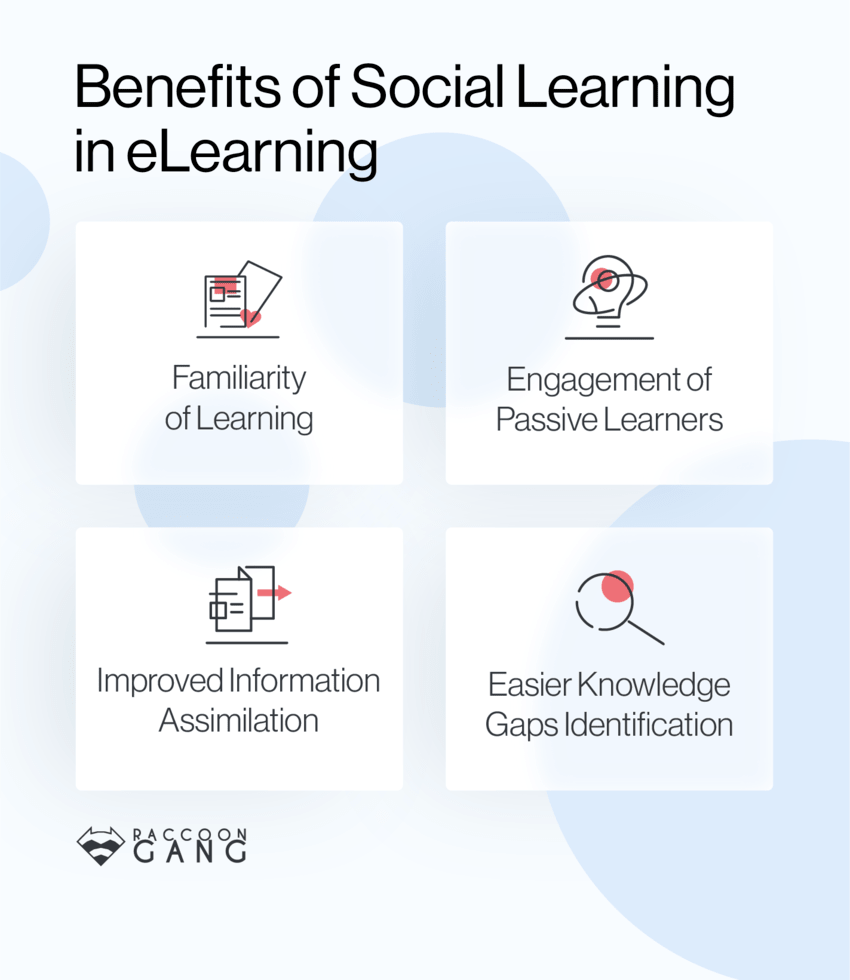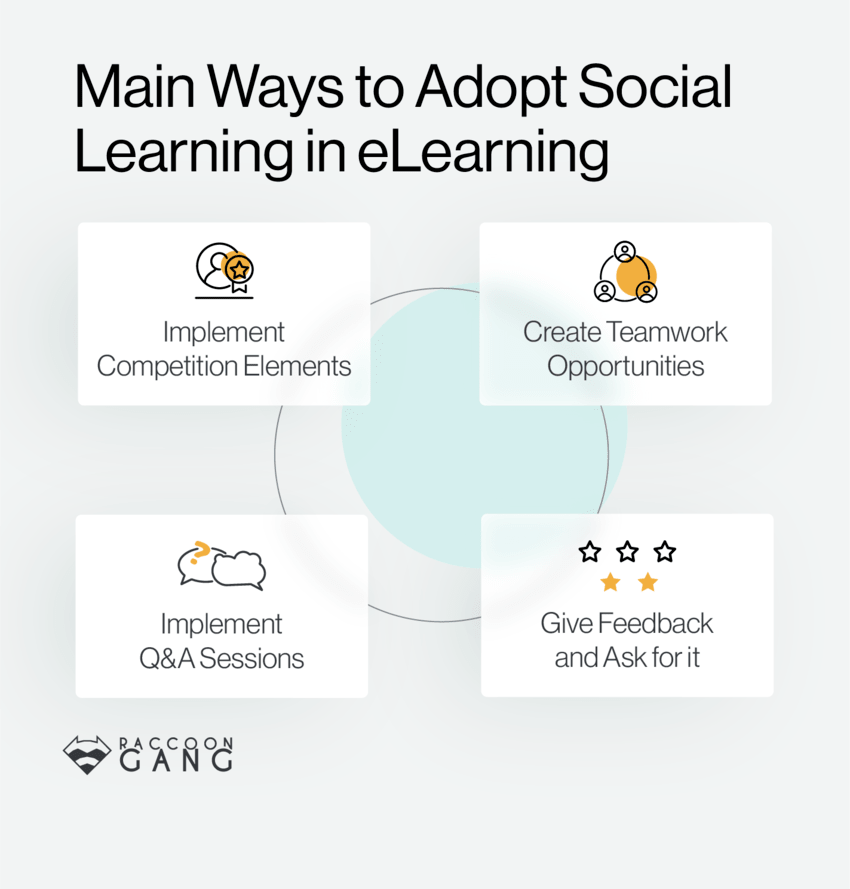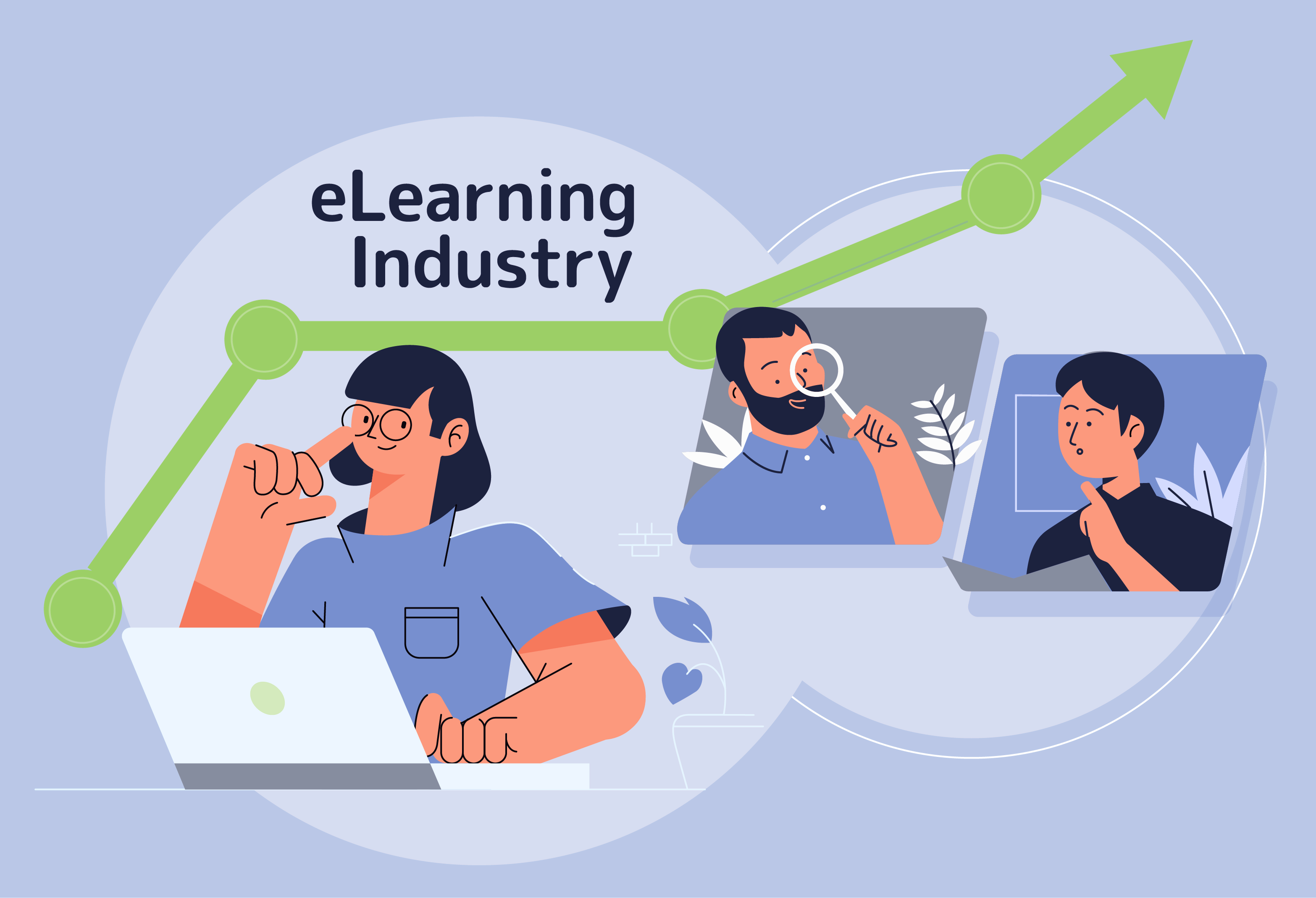What Social Learning Is All About?
Let’s go a little further and say that social learning goes far back to 1950, namely the theory of Albert Bandura, who stated that people learn better if they do it together. It’s all about the constant exchange of knowledge between group members and guidance, which helps students learn the material much better and faster.
Social learning in eLearning can have two different streams, namely direct and indirect social interactions between students. Direct contact implies personal communication (for example, a conference in Zoom), while indirect contact implies correspondence on social networks, via e-mail, and so on.
Main Elements of Social Learning
Social learning has several essential elements that distinguish this learning format from the rest and make it unique.
| Element of social learning | Meaning |
| Observational learning | You observe the principle of completing the task and then make this task yourself to correspond to the direction you just saw. The simplest example – you are shown how to string a tie, and you are trying to repeat all actions you saw. |
| Reciprocal determinism | Human behavior is both influenced and influenced by personal factors and the social environment. It is about the social interaction between man and other people in the environment. |
| Self-regulation | Social learning participants must have self-motivation and discipline to walk through the learning course, complete tasks, and increase productivity. |
| Self-efficacy | This element is based on self-confidence to complete assignments, apply gained knowledge, and much more. This is influenced by past learning experiences, observing the progress of other students, evaluating each other’s work, and much more. |
Benefits of Social Learning in eLearning
By building your eLearning process on social learning principles, you will receive several significant benefits that make this learning format a prevalent eLearning trend.
1.Naturalness and Familiarity of Learning
Many students may not even notice this, but social learning is one of the most natural forms of education. We studied in this way thousands of years ago, and this way of learning continues to work in the modern world. This learning method does not require planning or a separate timeframe. Everyone uses it naturally every day, consciously and unknowingly.
For example, the student was praised for the excellent answer. After that, other students began to analyze which elements in the colleagues’ responses were outstanding and honored by the teacher to use these elements for themselves. And this is just one of the simplest examples of the naturalness of social learning.
2. Fluent Collaboration and Engagement of Passive Learners
In social learning, the learning process itself is far from the only thing that happens in conjunction with other students. Students quite smoothly begin to help each other more often, seek advice and help, and better cooperate and learn in the process. This cohesion increases the productivity and speed of the eLearning process.
However, do not forget that we are all different. There will always be introverts in the group of active students who will find it challenging to integrate into such a cooperative learning process. Even though these situations may occur, don’t think that this training format is only suitable for extroverts. Social learning makes it easier for introverts to learn by listening to other people discuss their issues, which is one of the leading social learning principles. Still, there are challenges when implementing an LMS to support social learning, such as ensuring all learner types engage effectively and that the system fosters collaboration.
3. Improved Information Assimilation
For those who are more interested in the more precise side of the question, let’s say that numbers and statistics are on the side of social learning. For example, in standard learning, students remember about 5% of what they hear from the educator and about 10% of what they read in the educational material.
However, these numbers grow when students actively participate in the learning process, and as we already know, activity and interaction are the main features of social learning. With an active discussion of the material with other students, 50% of this material is assimilated. And this is one of the main reasons why the eLearning process should be developed based on social learning principles.
This learning strategy is relatively easy to organize in various open-source LMS systems, such as Open Edx. For example, using Open Edx’s internal tools, users can create and structure content-specific or broad discussion topics, making them public or completely anonymous. In addition, the platform supports the creation of divided discussions made only for students of a specific group. Flexible discussion control tools allow the educator to control the structure of threads, attaching important answers and thus making the discussion more clear for newcomers.
These are just some of Open Edx’s social learning and discussion creation opportunities. For a more profound introduction to the topic, you should contact a professional team specializing in working with Open Edx.
4.Easier Knowledge Gaps Identification
When students study together, they cover more teaching material and do it much faster. In addition, by introducing active discussions, checking each other’s assignments, and involving gamification elements in the learning process, you prevent knowledge gaps. If students don’t know something, they can always turn to other students for help, and they will present the material in an accessible form that will be quickly assimilated.
Main Ways to Adopt Social Learning in eLearning
After telling you what benefits you can get if you start using social learning in your eLearning process, you most likely want to know what methods can be used to implement some aspects of this learning method. We have collected four main options to help you implement social learning for your eLearning needs.
Create Teamwork Opportunities
The first step towards social learning is to create the right opportunities that will encourage interaction between students. To begin with, promote any kind of interaction between students so that they relax and understand that they are doing the right thing.
After that, it is worth introducing various tasks that will imply teamwork and interaction with each other. They can include multiple group projects, work in pairs, general discussion of a topic, evaluation of colleagues’ work, and much more. Without these elements, it is challenging to imagine formal social learning.
Implement Competition Elements
All people desire to compete with others and win, and these traits can be used in social learning to make it even more casual and engaging. You can use various gamification elements, such as leaderboards with a point system, achievements, and much more. For example, the Raccoon Gang team created the Gamification Management Tool for Gamma Project. We developed an algorithm for configurable rules for issuing the rewards, tools for creating personalized badges, and capabilities for adding new rewardable events to the system.
Implement Q&A Sessions
Q&A sessions are a highly interactive way of learning and are therefore very popular with learners. To implement them, the LMS you have chosen must support such functionality. Even if you do not have such features, these sessions can be organized in any tool for an online conference.
Give students time to collect questions of interest, schedule a time, invite SMEs or stakeholders, and start an organized session. Have each student ask questions of interest and receive detailed answers. And do not worry if any of the answers grow into a small discussion. Discussions work great on the digestibility of the material.
Give Feedback and Ask for it
Feedback is the basis for improving the learning process and should never be neglected. Praise students for excellent interaction, show other students where their colleague went wrong and how it was worth making this or that task more correct.
When giving feedback, do not forget about asking it for yourself. Allow students to evaluate the current social learning process and explain which elements are working well and need improvement. Find common ground and interact to improve the social learning process.
Wrapping Up
Social learning is one of the main trends in online learning for a reason. The naturalness of this eLearning trend makes it very easy to implement, and the benefits of this learning approach are significant. However, if you need special tools to help you create a unique social learning experience, specialists can help you develop custom eLearning solutions.
Raccoon Gang is a team of experts in custom eLearning solution development. Our main goal is to help customers realize all eLearning needs in the best way possible. Share your eLearning ideas and plans with us, and our representatives will contact you about future cooperation opportunities.
- What Social Learning Is All About?Let's go a little further and say that social learning goes far back to 1950, namely the theory of Albert Bandura, who stated that people learn better if they do it together. It's all about the constant exchange of knowledge between group members and guidance, which helps students learn the material much better and faster.Social learning in eLearning can have two different streams, namely direct and indirect social interactions between students. Direct contact implies personal communication (for example, a conference in Zoom), while indirect contact implies correspondence on social networks, via e-mail, and so on.Main Elements of Social LearningSocial learning has several essential elements that distinguish this learning format from the rest and make it unique. Element of social learning Meaning Observational learning You observe the principle of completing the task and then make this task yourself to correspond to the direction you just saw. The simplest example - you are shown how to string a tie, and you are trying to repeat all actions you saw. Reciprocal determinism Human behavior is both influenced and influenced by personal factors and the social environment. It is about the social interaction between man and other people in the environment. Self-regulation Social learning participants must have self-motivation and discipline to walk through the learning course, complete tasks, and increase productivity. Self-efficacy This element is based on self-confidence to complete assignments, apply gained knowledge, and much more. This is influenced by past learning experiences, observing the progress of other students, evaluating each other's work, and much more. Benefits of Social Learning in eLearningBy building your eLearning process on social learning principles, you will receive several significant benefits that make this learning format a prevalent eLearning trend.1.Naturalness and Familiarity of LearningMany students may not even notice this, but social learning is one of the most natural forms of education. We studied in this way thousands of years ago, and this way of learning continues to work in the modern world. This learning method does not require planning or a separate timeframe. Everyone uses it naturally every day, consciously and unknowingly.For example, the student was praised for the excellent answer. After that, other students began to analyze which elements in the colleagues' responses were outstanding and honored by the teacher to use these elements for themselves. And this is just one of the simplest examples of the naturalness of social learning.2. Fluent Collaboration and Engagement of Passive LearnersIn social learning, the learning process itself is far from the only thing that happens in conjunction with other students. Students quite smoothly begin to help each other more often, seek advice and help, and better cooperate and learn in the process. This cohesion increases the productivity and speed of the eLearning process.However, do not forget that we are all different. There will always be introverts in the group of active students who will find it challenging to integrate into such a cooperative learning process. Even though these situations may occur, don’t think that this training format is only suitable for extroverts. Social learning makes it easier for introverts to learn by listening to other people discuss their issues, which is one of the leading social learning principles. Still, there are challenges when implementing an LMS to support social learning, such as ensuring all learner types engage effectively and that the system fosters collaboration.3. Improved Information AssimilationFor those who are more interested in the more precise side of the question, let's say that numbers and statistics are on the side of social learning. For example, in standard learning, students remember about 5% of what they hear from the educator and about 10% of what they read in the educational material.However, these numbers grow when students actively participate in the learning process, and as we already know, activity and interaction are the main features of social learning. With an active discussion of the material with other students, 50% of this material is assimilated. And this is one of the main reasons why the eLearning process should be developed based on social learning principles.This learning strategy is relatively easy to organize in various open-source LMS systems, such as Open Edx. For example, using Open Edx’s internal tools, users can create and structure content-specific or broad discussion topics, making them public or completely anonymous. In addition, the platform supports the creation of divided discussions made only for students of a specific group. Flexible discussion control tools allow the educator to control the structure of threads, attaching important answers and thus making the discussion more clear for newcomers.These are just some of Open Edx's social learning and discussion creation opportunities. For a more profound introduction to the topic, you should contact a professional team specializing in working with Open Edx.4.Easier Knowledge Gaps IdentificationWhen students study together, they cover more teaching material and do it much faster. In addition, by introducing active discussions, checking each other's assignments, and involving gamification elements in the learning process, you prevent knowledge gaps. If students don’t know something, they can always turn to other students for help, and they will present the material in an accessible form that will be quickly assimilated.Main Ways to Adopt Social Learning in eLearningAfter telling you what benefits you can get if you start using social learning in your eLearning process, you most likely want to know what methods can be used to implement some aspects of this learning method. We have collected four main options to help you implement social learning for your eLearning needs.Create Teamwork OpportunitiesThe first step towards social learning is to create the right opportunities that will encourage interaction between students. To begin with, promote any kind of interaction between students so that they relax and understand that they are doing the right thing.After that, it is worth introducing various tasks that will imply teamwork and interaction with each other. They can include multiple group projects, work in pairs, general discussion of a topic, evaluation of colleagues' work, and much more. Without these elements, it is challenging to imagine formal social learning.Implement Competition ElementsAll people desire to compete with others and win, and these traits can be used in social learning to make it even more casual and engaging. You can use various gamification elements, such as leaderboards with a point system, achievements, and much more. For example, the Raccoon Gang team created the Gamification Management Tool for Gamma Project. We developed an algorithm for configurable rules for issuing the rewards, tools for creating personalized badges, and capabilities for adding new rewardable events to the system.Implement Q&A SessionsQ&A sessions are a highly interactive way of learning and are therefore very popular with learners. To implement them, the LMS you have chosen must support such functionality. Even if you do not have such features, these sessions can be organized in any tool for an online conference.Give students time to collect questions of interest, schedule a time, invite SMEs or stakeholders, and start an organized session. Have each student ask questions of interest and receive detailed answers. And do not worry if any of the answers grow into a small discussion. Discussions work great on the digestibility of the material.Give Feedback and Ask for itFeedback is the basis for improving the learning process and should never be neglected. Praise students for excellent interaction, show other students where their colleague went wrong and how it was worth making this or that task more correct.When giving feedback, do not forget about asking it for yourself. Allow students to evaluate the current social learning process and explain which elements are working well and need improvement. Find common ground and interact to improve the social learning process.Wrapping UpSocial learning is one of the main trends in online learning for a reason. The naturalness of this eLearning trend makes it very easy to implement, and the benefits of this learning approach are significant. However, if you need special tools to help you create a unique social learning experience, specialists can help you develop custom eLearning solutions.Raccoon Gang is a team of experts in custom eLearning solution development. Our main goal is to help customers realize all eLearning needs in the best way possible. Share your eLearning ideas and plans with us, and our representatives will contact you about future cooperation opportunities.
- Benefits of Social Learning in eLearning
- Main Ways to Adopt Social Learning in eLearning
- Wrapping Up





